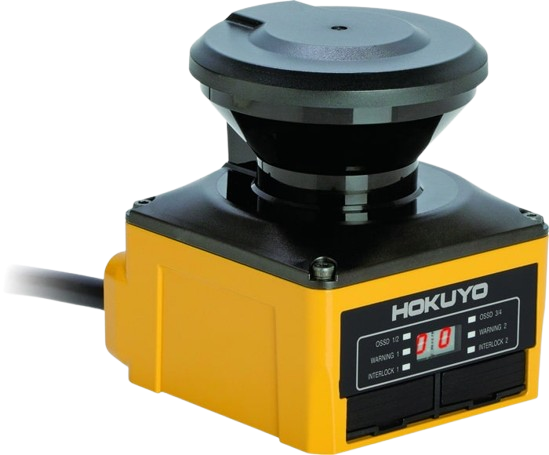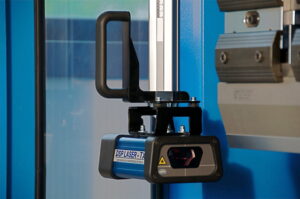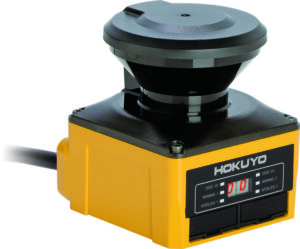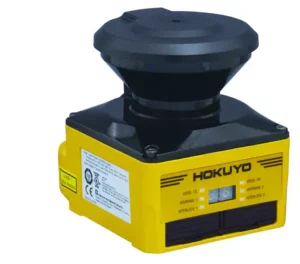Safety Laser Scanner Understanding Laser Scanning Technology What is a Laser Scanner? A laser scanner is a sensor-based device that uses infrared or laser light…
Safety Laser Scanner
Understanding Laser Scanning Technology
What is a Laser Scanner?
A laser scanner is a sensor-based device that uses infrared or laser light to detect objects, measure distances, and monitor defined zones. In industrial environments, these scanners serve critical roles in ensuring machine safety and process efficiency.

How Laser Scanners Work
Safety laser scanners operate by emitting a laser beam that sweeps across a designated area. The device calculates distance by measuring the time it takes for the beam to reflect off objects. With high-resolution scanning and multiple configurable fields, these scanners provide accurate object detection for both static and dynamic applications.
Types of Laser Scanners
Safety Laser Scanners
Designed specifically for personnel protection, safety laser scanners monitor hazardous areas around machines, automatically stopping equipment when someone enters a protected zone. These scanners support features like dual zone monitoring, PROFINET communication, and real-time diagnostics to comply with safety standards.
Area Laser Scanners
Area laser scanners offer wide coverage for access protection, especially in applications such as packaging lines, logistics zones, and automated systems. Their flexible mounting and integrated display options allow for simple setup and field configuration.
Industrial Laser Scanners
Engineered for industrial applications, these scanners are built to withstand harsh environments. From manufacturing lines to mining and excavation, industrial laser scanners provide environmental adaptability, enabling operations in dusty, wet, or variable temperature conditions.
Applications of Laser Scanners
Safeguarding Hazardous Areas
Laser scanners are used to establish virtual safety zones around machinery, preventing access to dangerous movement areas. With multi-zone configuration and area monitoring, they eliminate the need for physical barriers.
Automated Guided Vehicles (AGVs) Support
Supporting AGV navigation and obstacle detection, safety laser scanners for AGVs ensure smooth and safe movement across facilities. These scanners enable contour measurement and proximity detection, key to AGV operation in warehouse and logistics environments.
Access Protection and Dimensional Measurement
Beyond safety, scanners aid in dimensional measurement and profile detection, optimizing quality control in production processes.
Key Features of Modern Laser Scanners
Advanced Communication Options: PROFINET
With PROFINET and Ethernet/IP integration, safety scanners communicate seamlessly with higher-level control systems, allowing fast setup and remote diagnostics.
Integrated Displays and Configurable Fields
Modern scanners include integrated displays, offering intuitive status indication and quick access to settings. Configurable fields allow for dynamic safety zones that adapt to real-time processes.
Environmental Adaptability and Versatility
Safety laser scanners are built to handle IP65-rated environments, resistant to dust and water. Their compact size, flat actuator compatibility, and versatile mounting make them ideal for confined industrial spaces.
Laser Scanner Technologies
Overview of LiDAR Technology
Laser scanners use LiDAR technology to construct precise maps of their surroundings, commonly used in robotics and automated warehouses.
New Series for Contour Measurement
Recent developments include scanners with enhanced holding force, thermal management, and insulation voltage capabilities—suited for high-precision applications.
Scanners for AGV Navigation
AGV-compatible laser scanners offer robust access protection, accurate entry minimum detection, and reverse polarity protection to meet mobile safety requirements.
Case Studies and Real-World Applications
Production and Manufacturing
In manufacturing environments, scanners increase throughput by eliminating downtime due to physical guarding. Their safety outputs and monitoring zones integrate seamlessly into control systems.
Warehouse and Logistics
In warehousing, scanners secure entry points, manage dimensional accuracy, and enhance automated material handling systems.
Mining and Excavation
Laser scanners enable safe perimeter monitoring in mining operations, where dust, vibration, and extreme temperatures demand rugged devices with vibration resistance and thermal current tolerance.
Product Offerings and Comparisons
Hokuyo Safety Laser Scanner Overview
The Hokuyo safety laser scanner stands out as a compact, high-performance solution tailored for industrial safety applications and automated guided vehicles (AGVs). Known for its precision and reliability, the Hokuyo scanner offers:
- Wide area coverage with fast response times
- Compact design ideal for space-constrained environments
- Configurable safety zones for dynamic and multi-directional monitoring
- High switching resolution for detecting small obstacles in complex environments
- Integrated PROFINET and Ethernet connectivity for seamless integration with control systems
- Robust environmental protection, including dust and vibration resistance
Engineered with advanced LiDAR-based technology, Hokuyo scanners ensure both personnel protection and operational efficiency in warehousing, logistics, robotics, and mobile automation settings. Their lightweight build and flexible mounting options make them an optimal choice for mobile robot safety without compromising on performance.
Enhancing Safety and Productivity with Laser Scanners
Impact on Workplace Safety
Deploying laser safety devices significantly enhances workplace safety while maintaining high levels of automation. The Hokuyo safety laser scanner, in particular, offers a cost-effective, lightweight, and highly configurable solution ideal for mobile robotics and industrial automation.
Whether you’re safeguarding personnel, optimizing robotic workcells, or automating vehicle movement in warehouses, safety and area laser scanners are essential tools in modern machine guarding systems.
Advanced Capabilities of Safety Laser Scanners
Modern safety laser scanners offer a wide range of features designed to enhance both flexibility and protection across industrial environments. With the widest range of models available—from compact units for confined spaces to high-spec scanners for complex automation—users can select the ideal device for their application.
At the core of these systems lies the protective field, a programmable zone that detects any intrusion into hazardous areas. These fields can be adjusted to suit various applications, enabling precise access monitoring in dynamic environments such as packaging lines, robotic cells, or AGV pathways.
Key performance metrics such as angular resolution are critical for identifying object size and position accurately. A higher angular resolution ensures better detection of small objects and sharper edge definition—vital in safety-critical zones.
Many scanners are equipped with muting functions, allowing temporary suspension of safety zones during known, non-hazardous events—such as the entry of pallets or trolleys—without triggering alarms or shutdowns.
These advanced devices meet stringent safety levels as defined by international standards, often reaching up to SIL 3 or PLe. Integrated safety sensors continuously monitor the system’s integrity, ensuring that any failure is detected and addressed immediately to prevent risk to personnel.
Specialized Features and Emerging Technologies in Laser Scanners
Today’s laser scanning solutions are engineered with a host of specialized features to meet the demands of high-performance industrial environments. Many models now support a PROFINET interface with a built-in 2-port PROFINET switch, enabling flexible network options and simplified integration into complex automation systems.
With a 270-degree sensing angle and wide angular scanning range, scanners can monitor large zones with fewer blind spots, reducing the risk of false positives and improving object differentiation—even in crowded or dynamic workspaces. These features are particularly valuable near rolling machines, mobile sensors, or any nearby machine requiring active detection.
For advanced safety and control, many units include an integrated display and a removable connection unit, streamlining installation and field adjustments. Meanwhile, support for external signals and redundant signals enhances communication reliability in safety-critical applications.
Laser scanners are instrumental in material tracking across civil infrastructure projects and domain modelling applications, including geological modelling workflows and interconnected mine scheduling. With capabilities like pressure-sensitive zone detection and protective functions that maintain a safe distance, these devices help ensure compliance with industrial safety norms.
In modern systems, safety-related parts are monitored in real time for any internal fault, and intelligent field sets can be configured—some supporting up to 50 switchable 4-field sets—to match variable workflows. Scanners with serial interfaces also allow for flexible data communication in legacy and hybrid setups.
Use cases now extend to rapid prototyping, autonomous flying laser scanners, and even landmark projects like the Burj Al Arab, where capture reality scanning and typical laser sensors are employed for architectural precision. Whether handling massive objects or a typical object stream on production lines, these devices deliver peak efficiency and maximum efficiency without compromising safety.
With innovations such as 2-in-1 solutions and Active Opto-electronic Protective Devices (AOPDs), safety laser scanners continue to evolve—supporting applications that demand time assessments, high throughput, and scalable access programs.




